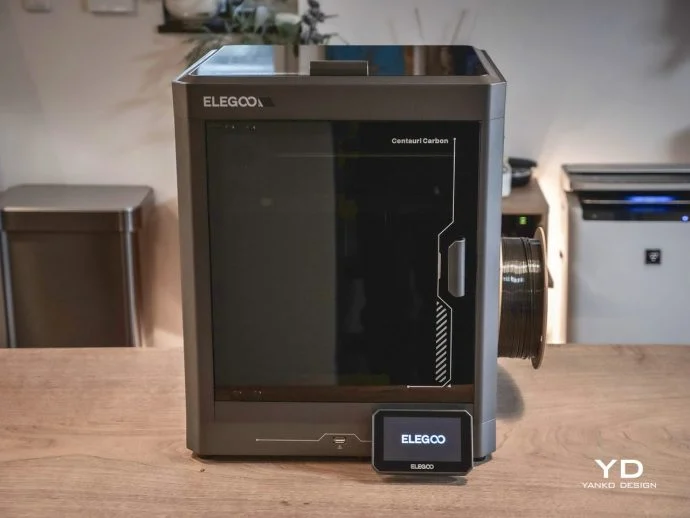3D printing has transformed the way creators, hobbyists, and professionals bring their ideas to life. Once an expensive and niche technology, it has now become more accessible, thanks to companies like Elegoo.
The Elegoo Centauri Carbon 3D printer is an exciting addition to the market, aiming to bridge the gap between affordability and high-end performance. This review takes an in-depth look at the Centauri Carbon, examining its features, performance, ease of use, pros, cons, and how it stacks up against the competition.
The Elegoo Centauri Carbon is a CoreXY-based 3D printer that offers high-speed printing, a fully enclosed structure, and a solid metal frame. With a build volume of 256 × 256 × 256 mm, a direct drive extruder, and compatibility with various filament types, it stands out as a promising option for both beginners and experienced makers.
But does it live up to expectations? Let’s find out.
Unboxing and First Impressions
When you first unbox the Elegoo Centauri Carbon, the immediate impression is that of a well-built, premium machine. Unlike many budget 3D printers that require extensive assembly, this one comes mostly pre-assembled, which is a major plus.
What’s in the box?
• Elegoo Centauri Carbon 3D Printer (pre-assembled)
• Power cable
• Tools for maintenance
• Extra nozzle
• Spool holder
• Sample filament
• User manual
The fully enclosed design is a standout feature. The metal frame and glass panels give it a sturdy and industrial feel. The magnetic PEI build plate is flexible, making it easy to remove prints without the struggle of prying them off.
CoreXY Kinematics for Speed and Accuracy
One of the most notable features of the Centauri Carbon is its CoreXY motion system, which improves speed and stability. Unlike traditional Cartesian-style printers, CoreXY reduces vibrations and enhances print accuracy, making it an excellent choice for high-speed printing.
The printing speed reaches up to 500 mm/s, which is impressive, especially considering that many entry-level 3D printers operate at around 60-100 mm/s.
Fully Enclosed Printing Chamber
Enclosed 3D printers are preferred for materials that require consistent temperatures, such as ABS, ASA, and PETG. The Elegoo Centauri Carbon’s enclosure helps minimize warping and maintain a stable print environment. However, one drawback is that the internal lighting is somewhat dim, making it harder to monitor prints.
Direct Drive Extruder with Hardened Gears
A direct drive extruder is beneficial for flexible filaments like TPU, as it allows for better filament control compared to Bowden-style extruders. The hardened steel gears and nozzle make it compatible with abrasive filaments, including carbon fiber-infused materials.
Automatic Bed Leveling
Bed leveling is often one of the most frustrating aspects of 3D printing. Fortunately, the Centauri Carbon features automatic bed leveling using strain gauge technology, ensuring a smooth first layer without manual adjustments.
PEI Build Plate
The magnetic PEI-coated build plate provides excellent adhesion and easy removal of prints. Unlike traditional glass beds, where prints might stick too firmly or not at all, the PEI sheet allows for effortless print removal by simply bending the plate.
User-Friendly Interface
The 4.3-inch touchscreen display is simple and easy to navigate. While the firmware could use some refinements, it remains functional and intuitive for most users.
Setup and Calibration
Setting up the Centauri Carbon is straightforward, taking around 15-20 minutes. Since it arrives mostly pre-assembled, users only need to:
Attach the spool holder.
Plug in the power cable.
Load the filament.
Run the automatic bed leveling process.
Start a test print.
Once calibrated, the printer is ready to go. The firmware update process is simple, though some users have reported occasional freezes or file upload failures. While these are minor inconveniences, Elegoo is actively releasing updates to improve the experience.
Print Performance and Quality
PLA & PETG
Printing with PLA and PETG on the Centauri Carbon is flawless. The enclosure helps reduce warping, especially with PETG, which benefits from consistent temperatures. The print details are crisp, with minimal stringing and excellent layer adhesion.
ABS & Nylon
Since ABS and Nylon require higher temperatures and controlled environments, the enclosed chamber is a plus. However, the chamber does not get hot enough for optimal ABS performance, leading to occasional warping. For best results, preheating the chamber or using a heated enclosure is recommended.
Carbon Fiber-Infused Filaments
One of the biggest selling points of the Centauri Carbon is its compatibility with carbon fiber-infused filaments. The hardened steel extruder and nozzle handle these materials well, producing rigid and durable prints with superior strength-to-weight ratios.
Flexible Filaments (TPU)
Thanks to the direct drive extruder, printing TPU and other flexible materials is smooth, with minimal clogging or under-extrusion issues. This makes the printer a great option for those who need flexible parts.
How Does It Compare to Other Printers?
When compared to the Bambu Lab P1P and Creality K1 Max, the Centauri Carbon is much more affordable while offering similar features. However, Bambu Lab’s firmware and ecosystem are more polished, while the Creality K1 Max offers a larger build volume.
Final
The Elegoo Centauri Carbon 3D printer is a fantastic choice for users looking for high-quality prints at an affordable price. With CoreXY motion, a fully enclosed design, a direct drive extruder, and hardened steel components, it provides excellent value for hobbyists, professionals, and even small businesses.
While there are minor firmware and visibility issues, these do not overshadow its strong performance. If you’re looking for an enclosed, high-speed 3D printer that can handle a variety of materials, the Centauri Carbon is a great investment.
Who Should Buy It?
Beginners who want a user-friendly yet powerful printer.
Makers & Hobbyists who need a high-speed CoreXY system.
Professionals who require high-quality prints with abrasive materials.
If Elegoo continues improving its firmware, the Centauri Carbon could become a top-tier competitor in the affordable 3D printing space.
No comments yet.








